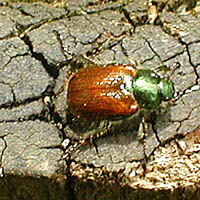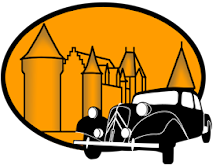Rose Chafer Cetonia aurata
Sometimes called the Green Rose Chafer. Usually metallic green, but can be bronze. Always has some white markings. Coppery red underneath. Adults active May - October, in the sun, eating flowers. The larvae live in rotting timber, especially old willows. Common and unmistakable in this area. In French - la Cétoine dorée or hanneton des roses. Maria Fremlin has been studying them in Colchester, Essex, England, for several years and has some useful information and links on her website ('Know your Chafers', an article she wrote in 2008 is particularly useful). She also recommends André Lequet's page on Rose Chafers, which gives even more details on life cycles and also shows how to tell male from female. Both are at pains to point out that the Rose Chafer grubs do not eat plant roots, but rotting plant material (such as compost).
A Rose Chafer buries itself in the soil in March.

 |
| In an artichoke flower. |
 |
| Feeding on rose stamens -- one of their favourite foods. |
Cockchafer Melolontha melolontha
Often called Maybug, this large beetle (25 -30 mm) is found in gardens, woods and hedgerows from April-June. You may encounter them on bushes and along walking trails in the spring. Often observed swarming around trees on summer evenings or crashing into lit windows. Eats the leaves of deciduous trees. The larvae eat plant roots and can cause damage to crops and lawns (they are one of the prey that corvids in fields are seeking). Modern pest control has meant that this species is much less abundant than it used to be, but it is still common, with a lifecycle that means that every 3-4 years there are higher numbers. Called le hanneton commun in French. Don't confuse with the Summer Chafer Amphimallon solstitialis which is smaller. Below, 13 photos of a female Cockchafer, taken in Preuilly-sur-Claise, April.













Tropinota hirta/squalida
A common chafer often found eating the centres of flowers of many kinds. It can be an agricultural pest. Very hairy, with variable white markings on the elytra (wing cases). Do not confuse with Oxythyrea funesta, which has white spots on the pronotum (the section between the head and the wing cases) as well. Le Jardin de Lucie has an excellent post on how to tell T. hirta, T. squalida and O. funesta apart. Known as la cétoine poilue in French (='the hairy chafer'). Below, 5 photographs of this species in a buttercup Ranunculus sp, taken in our orchard, April.





 |
| Feeding on a dandelion Taracacum sp. |
Valgus hemipterus:
A small fairly common chafer that can be found on flowers or wood in May and June. They have particularly short elytra. Do not confuse with the species above.Le Jardin de Lucie has an excellent post with detailed photos and lots of information here. This one, photographed in our vegetable garden on a dead iris flower, is male.

Garden Chafer Phyllopertha horticola:
A small species, the pronotum (section between the head and body) is sometimes nearly black and the elytra can have blue or green iridescence. Adults are visible in June and July, in dry places, often swarming where it is sunny. They feed on a wide range of woody and herbaceous plants and can be a pest of fruit crops. The larvae eat grass roots. The one below was photographed at the Etang Neuf hide in the Réserve naturelle de la Chérine in the Brenne.







I call the Summer Chafer...
ReplyDeletebat food!
We find so many sets of wings, head and thorax around the buildings.
Tim: Nice observation.
ReplyDelete